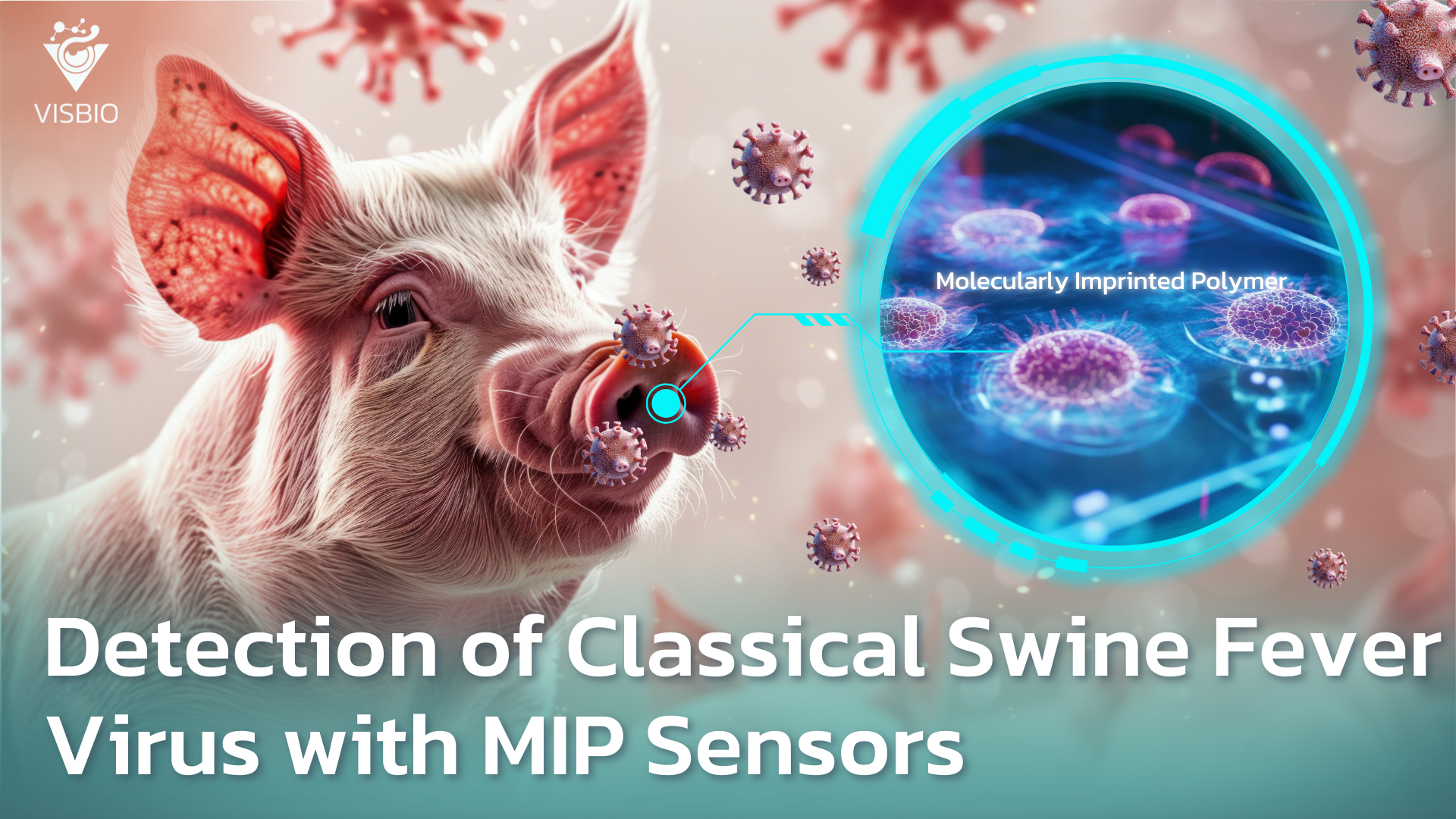Classical Swine Fever: Tackling One of Agriculture’s Biggest Challenges
Classical Swine Fever Virus (CSFV), also known as hog cholera, remains a devastating issue for pig populations worldwide. Its highly contagious nature makes it one of the most feared diseases in livestock farming, leading to significant economic losses for farmers and countries reliant on pork exports. Quick, accurate detection is key to controlling outbreaks and preventing the financial fallout associated with trade restrictions. Traditional diagnostic tools, while effective, often involve complex procedures and high costs, making them impractical for large-scale use in the field.
However, recent research spearheaded by Associate Professor Dr. Kiattawee Choowongkomon and his team offers a transformative solution—molecularly imprinted polymer (MIP) sensors on quartz crystal microbalances (QCM) for detecting CSFV. This innovative, cost-effective method is poised to revolutionize veterinary diagnostics by making rapid, accurate virus detection accessible for a wide range of agricultural settings.
Leading the Way in CSFV Detection with MIP Technology
An Innovative Approach to Viral Detection
The MIP technology used in this research is a cutting-edge alternative to traditional diagnostic methods. Molecularly imprinted polymers are synthetic materials engineered to recognize specific molecules. In this case, MIPs are imprinted with the molecular “template” of CSFV, allowing them to selectively bind to the virus particles. These imprinted polymers, combined with QCM technology, provide an efficient and affordable method to detect the virus based on changes in mass at the sensor’s surface.

Precision and Selectivity
The MIP-QCM sensor offers high sensitivity, detecting CSFV at concentrations as low as 1.7 μg/mL. This allows for the early detection of the virus, which is critical for preventing the spread of disease among pig populations. In tests, the sensor demonstrated exceptional selectivity, distinguishing CSFV from other viral threats to pigs, such as porcine respiratory and reproductive syndrome virus (PRRSV) and pseudorabies virus (PRV). This selectivity ensures that the sensors only react to CSFV, reducing the likelihood of false positives—a key advantage over traditional diagnostic tools like ELISA, which can sometimes produce inaccurate results due to cross-reactions.
Cost-Effective and Scalable for Real-World Applications
Affordability Meets Innovation
One of the standout benefits of the MIP-QCM sensor is its affordability. Unlike other detection systems, which require expensive reagents or advanced laboratory equipment, MIPs are composed of inexpensive, readily available chemicals. With each sensor estimated to cost under €10, this technology offers a low-cost alternative to traditional diagnostic methods such as PCR or ELISA, which are often too costly and complex for routine use in field settings.
Scalable for Large-Scale Deployment
The scalable nature of MIP-QCM sensors means they can be produced at a fraction of the cost of conventional methods. The simple production process involves imprinting polymers with the virus template, making it possible to manufacture these sensors in large quantities for use in farms, veterinary clinics, or quarantine stations. This scalability ensures that even small-scale operations can benefit from the technology, helping to democratize access to advanced diagnostics in agriculture.
What Does This Mean for Your Business?
A Game-Changer for Livestock Management
 For businesses involved in livestock farming, veterinary services, or agriculture, the introduction of MIP-QCM technology represents a significant step forward in animal health management. CSFV outbreaks not only lead to massive economic losses but also jeopardize a farm’s ability to export pork products. By adopting this technology, businesses can protect their herds with early detection, reducing the risk of widespread infection and the financial fallout from halted production or trade restrictions.
For businesses involved in livestock farming, veterinary services, or agriculture, the introduction of MIP-QCM technology represents a significant step forward in animal health management. CSFV outbreaks not only lead to massive economic losses but also jeopardize a farm’s ability to export pork products. By adopting this technology, businesses can protect their herds with early detection, reducing the risk of widespread infection and the financial fallout from halted production or trade restrictions.
Enhancing Efficiency and Reducing Costs
 Traditional CSFV detection methods, like polymerase chain reaction (PCR) tests or enzyme-linked immunosorbent assays (ELISA), often require expensive equipment, trained personnel, and significant time investment. These tests may not be feasible for smaller farms or remote locations where rapid diagnostics are needed. The MIP-QCM sensor is designed for ease of use in various environments, including point-of-care testing. It allows businesses to conduct on-site diagnostics quickly and affordably, reducing the need for complex laboratory testing.
Traditional CSFV detection methods, like polymerase chain reaction (PCR) tests or enzyme-linked immunosorbent assays (ELISA), often require expensive equipment, trained personnel, and significant time investment. These tests may not be feasible for smaller farms or remote locations where rapid diagnostics are needed. The MIP-QCM sensor is designed for ease of use in various environments, including point-of-care testing. It allows businesses to conduct on-site diagnostics quickly and affordably, reducing the need for complex laboratory testing.
Strengthening Your Reputation for Quality
 As global regulations around animal health and food safety tighten, ensuring that your pork products meet international standards is crucial. The ability to detect CSFV early and accurately gives your business a competitive edge in the market. By adopting this technology, you not only safeguard your livestock but also build trust with consumers and trade partners, ensuring your products are viewed as safe and reliable.
As global regulations around animal health and food safety tighten, ensuring that your pork products meet international standards is crucial. The ability to detect CSFV early and accurately gives your business a competitive edge in the market. By adopting this technology, you not only safeguard your livestock but also build trust with consumers and trade partners, ensuring your products are viewed as safe and reliable.
Real-World Impact
 This groundbreaking sensor technology has the potential to revolutionize how veterinary diagnostics are conducted. By integrating MIP-QCM sensors into your operations, you can improve decision-making, reduce response time, and minimize the spread of infection within your herds. For farms looking to modernize and streamline their operations, adopting this technology could be the key to improving overall efficiency and profitability.
This groundbreaking sensor technology has the potential to revolutionize how veterinary diagnostics are conducted. By integrating MIP-QCM sensors into your operations, you can improve decision-making, reduce response time, and minimize the spread of infection within your herds. For farms looking to modernize and streamline their operations, adopting this technology could be the key to improving overall efficiency and profitability.
A New Era of Veterinary Diagnostics
Simplifying Virus Detection in Agriculture

The development of molecularly imprinted polymers for virus detection is a testament to the power of innovative research in solving real-world problems. This MIP-QCM sensor technology offers a unique combination of affordability, precision, and scalability, making it an ideal solution for the global swine industry. Whether you’re managing a small farm or a large-scale agricultural operation, integrating this technology into your disease prevention strategy could transform how you handle livestock health, ultimately leading to better outcomes and lower costs.
Partner with Us for Cutting-Edge Diagnostic Solutions
If your business is looking to stay ahead of the curve in veterinary diagnostics, now is the time to explore how MIP-QCM technology can enhance your operations. Contact us today for a free consultation and discover how this revolutionary technology can help you protect your livestock, improve your diagnostic capabilities, and ensure long-term success in the agriculture industry.
About the Author
 Associate Professor Dr. Kiattawee Choowongkomon is a leading figure in biochemical research, with expertise in developing molecular sensors and diagnostic tools, Through research collaborations with leading institutions both in Thailand and internationally, Associate Professor Dr. Kiattawee work practical applications and potential to drive innovation in various industries.
Associate Professor Dr. Kiattawee Choowongkomon is a leading figure in biochemical research, with expertise in developing molecular sensors and diagnostic tools, Through research collaborations with leading institutions both in Thailand and internationally, Associate Professor Dr. Kiattawee work practical applications and potential to drive innovation in various industries.
About the Research
This research introduces a novel method for detecting classical swine fever virus (CSFV) using molecularly imprinted polymers (MIP) on quartz crystal microbalance (QCM) sensors. The study highlights the sensors’ sensitivity, selectivity, and scalability, offering a practical solution for rapid, cost-effective virus detection in agricultural settings. The research was published in Heliyon, with DOI: 10.1016/j.heliyon.2020.e04137.



